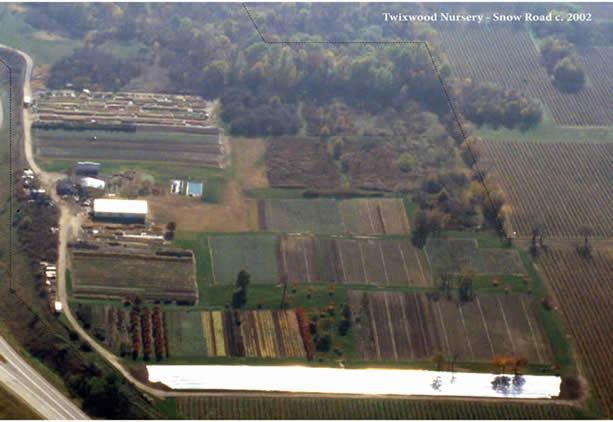We attend all of the regional nursery conventions and trade shows during the winter. We have a booth and we try to sell things while giving the illusion that we are taking the business seriously and trying. Then, we go around the convention hall and harass all of the other groundcover growers. Sometimes we learn things. For example, we learned that one of the groundcover suppliers out of Georgia is always short of Pachysandra ‘Green Sheen’. Now then, we were told years ago when this plant was just discovered, somewhere out on the East Coast we think, that ‘Green Sheen’ was a superior plant that was to be in great demand and so we established lots of cutting beds.
It was after all of these beds were planted and growing that we discovered that this plant reverted to a very dull looking pachysandra. At least it was distinctive enough that we could easily go through the beds prior to taking cuttings and pull up the reverted ones, hopefully getting as much of the roots as we could. There was maybe a one percent reversion per year, we were not scientific about counting, but it was enough to dishearten us about the plant. Besides, the deeply curled leaves and the extra-shiny polished look were not attractive to us. We were used to the ‘Green Carpet’ version with its flat and even leaves whereas the ‘Green Sheen’ had an irregular highly varied surface look. Because of personal taste I plowed under about half of our beds of ‘Green Sheen’.
And so now we are planning on increasing our production if we can sell this ‘Green Sheen’ to other nurseries. We are interested in and aware of ethics. We think that ethics consists of labelling our plants correctly and, whenever we have the opportunity, to describe them accurately to the extent of our observational experience. As an example, a few years ago, I wrote something about Pachysandra ‘Silveredge’, the variegated one, saying that it was uglier than sin, that it was a weak grower, and that it often reverted to green. I was puzzled when sales dropped after that. I had no idea that anyone either read what I wrote or believed me. My wife tells me that I should be careful about what I say because sometime somewhere someone will believe me.
The Pachysandra ‘Green Carpet’ story reminded me that we have, here at the nursery and historically, tried to get the improved plant varieties with another good example being Thorndale Ivy, Hedera helix, which is English Ivy. We understand that ‘Thorndale’ is a little bit hardier, after all they use it in Chicago, and has a better winter color what with the white veining and the slightly reddish tint when it gets really cold. We used to sell a lot of ivy in Chicago and the reason is that about every third or fourth year it would winter-kill. A lot was needed to replace it. Ivy must have looked good in between times because the optimists would re-plant, making this one of my favorite plants.
Thinking about plants that are easy to grow and that are attractive enough to be planted in large amounts and that, we are told, winter-kills sometimes in Chicago, there is Carex ‘Ice Dance’, a tall variegated clumping carex. We have no idea how hardy plants are because we are exactly ten miles east of Lake Michigan and the cold winds blow from the west around here, meaning that two things happen—the temperature is moderated and we get a lot of lake effect snow that insulates. If we knew from personal experience that ‘Ice Dance’ dies regularly then we might say something about it or put a card in the flats of plants as we deliver them with a warning, but we have no way of really knowing. In the meantime, we will do what we always do here at Twixwood—we will grow lots of it and write about it. This winter, which is the time to propagate carexes, we are making all kinds of ‘Ice Dance’ so as to never run out. We are going to ride this horse as far as it will go. I hope that nothing I say will disturb the sales.
For some reason I am reminded of Liriope muscari ‘Big Blue’. We like to grow unlimited amounts, and in any size from a 2 ½” pot on up, of Liriope spicata which is a lower growing, much hardier, and highly stoloniferous plant. It spreads and thickens up making a solid green grass-like mat with great abandon. Besides, we have fields of the spicata variety that we can dig and divide all of the time and in the heat of summer. The ‘Big Blue’ grows slow for us in the fields and so we have to buy the liners and plugs in from the South were it is more comfortable. People must like it. I have no idea why. It remains in a clump and gets tall. Maybe there is something about the bloom, which I consider to be inconsequential, that makes it attractive. And so we are producing enough of that to satisfy the market. Horse riding comes to mind.
This rambling discussion of hardiness reminds me of a lengthy discussion I got into years ago when perennials were just coming into vogue and there was a newer landscaper over north of Chicago who had a really difficult exposed patio thing that they wanted to plant. I suggested Perovskia as being something that would grow in heavy soil and survive the winters and then bloom all summer even though I am not a landscaper or a designer, lacking in all kinds of good taste as well as education, but I do grow things out in the fields in long straight rows and sometimes they bloom and I enjoy the colors. This aforementioned newish landscaper had read someplace about some Achillea or the other being ‘hardy’ and they not being very educated thought that this meant ‘hearty’. It took me a long time to figure out why they were so insistent on using the achillea; we had a homophone problem. My figuring out the problem did not make the discussion go any smoother. I have long forgotten how this turned out. At least we did not hear about it in the years afterwards. Maybe the landscaper went out of business due to ineptitude. Maybe they were sensitive.
And so the struggle continues. When I get the time I will go on for hours about Euonymous coloratus Purple-leaf Wintercreeper and everything that we have tried as a substitute for it from Cotoneaster dammeri ‘Nordic Carpet’ on up. We are now busily building up cutting stock of an Arctostaphylus uva-ursi collected from an exposed location in Northern Illinois growing on limestone. We are all hoping that this strain will not require the acidic soil conditions reputed to be necessary for the regular Arctostaphylus ‘Massachusetts’ strain that we all grow because it is easy to propagate. And then we will have a low-growing evergreen groundcover with flowers and berries and a reddish fall color and everything except scale and crown gall.
I spend a lot of time thinking about philosophy when I should be thinking about making more money in this business.

